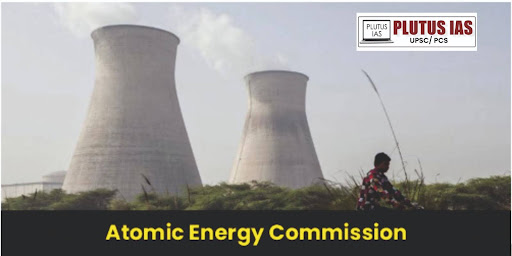17 Jan Prelims Bits: Department of Atomic Energy (DAE)
This article covers “Daily Current Affairs,” and the topic details related to ” Prelims Bits: Department of Atomic Energy (DAE)”
Syllabus mapping:
GS: Science and Technology- Nuclear Technology.
For Prelims:
What are DAE and AEC’s functions and mandates?
Why in the news?
The Government of India has reconstituted the Atomic Energy Commission (AEC), as announced through a notification published in the Gazette on January 9. Initially established in August 1948 under the Department of Scientific Research, the AEC plays a pivotal role in formulating policies for the Department of Atomic Energy (DAE).

Department of Atomic Energy (DAE)
Establishment and Overview
Founded: August 3, 1954, under the direct charge of the Prime Minister through a Presidential Order.
Type: Non-statutory, Non-Constitutional body, Executive Body under the direct Charge of the PMO.
Objective: To transact all Government of India business related to atomic energy as per the Atomic Energy Act, 1948.
Atomic Energy Commission (AEC): Established on March 1, 1958, with full executive and financial powers to formulate policies for the DAE.
Composition of the AEC:
Chairman: The Chairman of the AEC is the Secretary to the Government of India in the Department of Atomic Energy (DAE). The current Chairman is Dr. Ajit Kumar Mohanty, who took over from Kamlesh Nilkanth Vyas in May 2023.
Other Members: Members of the AEC are appointed on an annual basis for each calendar year. The Chairman recommends the members, and their appointments are subject to approval by the Prime Minister of India.
| Objective of Atomic Energy Commission (AEC) | Details |
|---|---|
| Peaceful Utilization of Atomic Energy | Harness atomic energy for applications that benefit humanity, such as energy and research. |
| Advancement of Nuclear Science and Technology | Promote R&D in nuclear science to enhance India’s technological and scientific capabilities. |
| Electricity Production from Atomic Energy | Expand nuclear power generation to ensure energy security and reduce reliance on fossil fuels. |
| Agricultural Enhancements | Use radiation-based techniques to increase food grain yield and improve shelf life. |
| Nanotechnology Development | Advance nanotechnology for applications in medicine, energy, and materials science. |
Organizational Structure of The DAE
Research Centers (6): BARC (Mumbai), IGCAR (Kalpakkam), RRCAT (Indore), VECC (Kolkata), AMDER (Hyderabad), GCNEP (Bahadurgarh).
Industrial Organizations (3): NFC (Hyderabad), HWB (Mumbai), BRIT (Mumbai).
Public Sector Undertakings (5): NPCIL (Mumbai), BHAVINI (Kalpakkam), ECIL (Hyderabad), UCIL (Jaduguda), IREL (Mumbai).
Service Organizations (3): DCSEM (Mumbai), DPS (Mumbai), GSO (Kalpakkam).
Grant-in-Aid Institutes (11): TIFR, SINP, TMC, HRI, IoP, NISER, IMSc, IPR, HBNI, UM-DAE CEBS, AEES.
Boards Under DAE
Board of Research in Nuclear Sciences (BRNS): Promotes extramural research in nuclear and allied fields.
National Board for Higher Mathematics (NBHM): Supports advanced research in mathematics.
Mandate and Functions
Development of nuclear power technology and applications in power and non-power domains.
Exploration, identification, and processing of uranium resources and atomic minerals.
Power sector application:
1. Fabrication of nuclear fuel.
2. Production of heavy water.
3. Construction and operation of nuclear power plants.
4. Nuclear fuel reprocessing and waste management.
5. Research and development in: Fast reactor and fusion technologies.
6. Accelerator and laser technologies, Advanced electronics and materials science, and Biological sciences for healthcare and agriculture.
Non-power applications: Isotopes and radiation technologies for healthcare, food, agriculture, industry, and environmental protection.
Key Achievements and Contributions of DAE:
Pioneering R&D in nuclear energy and allied disciplines: Development and operation of the Trombay Atomic Energy Establishment (1957), now BARC, which spearheads nuclear research in India. Indigenous design and construction of Pressurized Heavy Water Reactors (PHWRs), contributing significantly to India’s nuclear power capacity.
Societal applications of spin-off technologies: The development of Bhabhatron, a low-cost cancer therapy machine, is revolutionizing cancer treatment in India and abroad. Production of radiation-processed seeds for higher-yield crops, enhancing agricultural productivity.
Urban waste management solutions: Implementation of Nisargruna Biogas Plants, converting organic waste into clean energy. Development of advanced technologies for treating and managing municipal waste in cities.
The synergy between research, development, and technology deployment: Establishment of the Fast Breeder Test Reactor (1985) at Kalpakkam, advancing breeder reactor technology. Contribution to India’s Mars Orbiter Mission (Mangalyaan) by providing critical materials and nuclear-grade components.
Enhancing energy security and fostering growth: Commissioning of the Kudankulam Nuclear Power Plant (2013), built with international collaboration. Supporting industrial growth through partnerships like Nuclear Fuel Complex (NFC) and Heavy Water Board (HWB) for nuclear fuel and heavy water production.
Prelims Question:
Q. With reference to the Atomic Energy Commission (AEC) Consider the following statement:
1. The AEC is a statutory body constituted under The Atomic Energy Act of 1948.
2. The AEC is mandated to regulate the power and non-power use of atomic minerals.
3. Indigenous design and construction of Pressurized Heavy Water Reactors (PHWRs) is one of the contributions of the AEC.
How many of the above-given statements are correct?
(a) Only one
(b) Only two
(c) All three
(d) None
ANSWER: B




No Comments